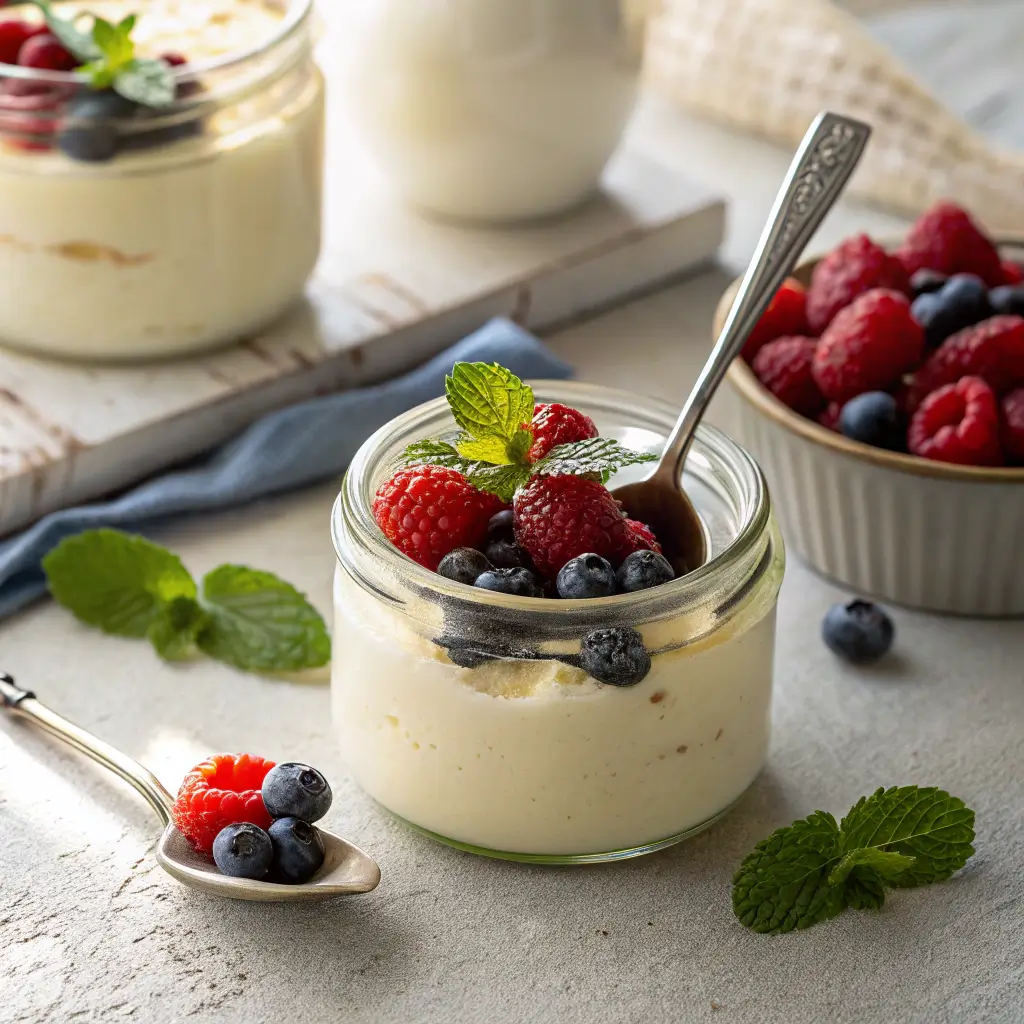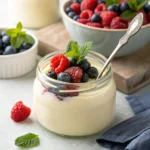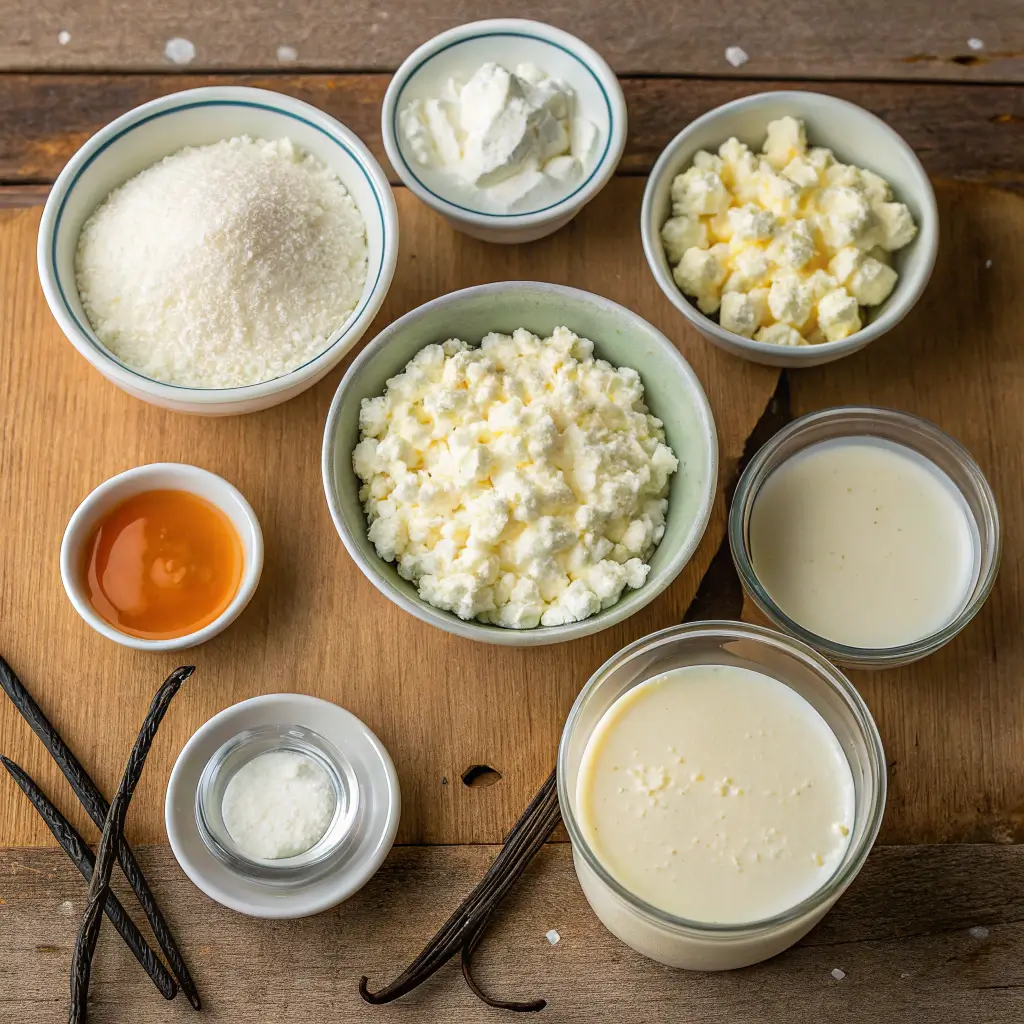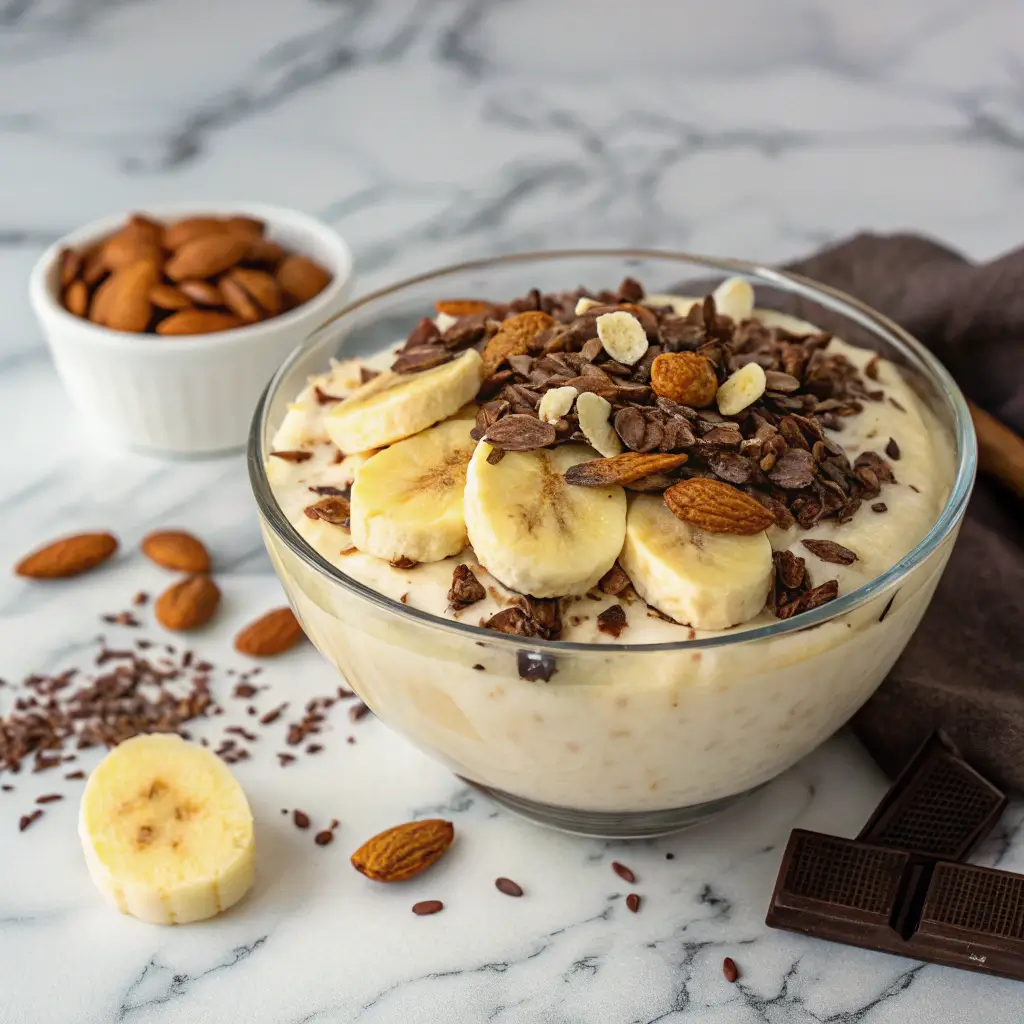
Cottage cheese pudding is one of those hidden gems in the dessert world—unexpectedly delicious, surprisingly healthy, and incredibly easy to make. This versatile treat combines the creamy texture of pudding with the high-protein benefits of cottage cheese, making it an excellent option for health-conscious foodies, fitness lovers, and anyone craving a guilt-free dessert.
In this guide, you’ll learn everything you need to know about making, enjoying, and even customizing cottage cheese pudding. From health benefits to flavor variations, this deep-dive covers it all.
Looking for inspiration? Try our Lemon Cottage Cheese Cake for another unique take on cottage cheese desserts.
Print
Cottage Cheese Pudding
- Total Time: 5 minutes
- Yield: 2 servings
Description
Cottage cheese pudding is a creamy, protein-packed dessert that’s unexpectedly delicious and guilt-free. This simple, no-bake treat blends cottage cheese with a few pantry staples to create a silky, versatile dish you can enjoy any time of day.
Ingredients
- 1 cup full-fat cottage cheese
- 1 tablespoon honey or maple syrup
- 1/2 teaspoon vanilla extract
- 2 tablespoons milk or almond milk
- Pinch of cinnamon or nutmeg (optional)
Instructions
- Add all ingredients into a high-speed blender.
- Blend for 30–60 seconds until smooth and creamy.
- Taste and adjust sweetness if needed.
- Pour into serving bowls or jars.
- Chill in fridge for 30 minutes before serving.
- Top with fruits, granola, or crushed nuts.
Notes
Use high-quality cottage cheese for the best texture. For variations, try mixing in cocoa powder, banana, or chia seeds.
- Prep Time: 5 minutes
- Cook Time: 0 minutes
- Category: Dessert
- Method: No-Bake
- Cuisine: Healthy
Table of Contents
Table of Contents
Cottage Cheese Pudding
Why You’ll Love This Cottage Cheese Pudding
This high-protein cottage cheese pudding is a game-changer for anyone looking for a healthy dessert or breakfast option. Here’s why you’ll keep coming back to this simple 3-ingredient recipe:
- Packs over 25g of protein per serving – perfect for muscle recovery, post-workout snacks, or satisfying cravings without guilt.
- Only 3 ingredients needed – no fancy tools or long prep time. Just blend and chill!
- Endless flavor variations – from cookies and cream to chocolate peanut butter, this base recipe is like a blank canvas for your creativity.
- Healthy enough for breakfast or a late-night treat – made with real food ingredients that nourish your body while still tasting indulgent.
If you’re into high-protein desserts, be sure to try our cottage cheese cheesecake or protein brownies next.
Don’t miss our Cottage Cheese Salad for a savory way to enjoy cottage cheese.
Health Benefits of Cottage Cheese Pudding
Protein-Rich and Low-Carb Profile of Cottage Cheese
Cottage cheese is one of the highest protein dairy products available, making it a nutritional powerhouse. In every 100 grams, it contains approximately 11 grams of protein, which helps support muscle repair, growth, and satiety. That’s why it’s a top choice for athletes and those following a high-protein or low-carb diet.
Cottage cheese pudding offers all the benefits of this dairy protein but in a sweet, dessert-friendly format. Combined with other low-carb ingredients like almond milk or chia seeds, it becomes an ideal option for:
- Keto dieters
- Low-carb enthusiasts
- Diabetics seeking dessert alternatives
Plus, its low glycemic index helps maintain stable blood sugar levels, keeping energy and cravings in check.
How Cottage Cheese Pudding Supports Weight Loss and Muscle Recovery
This pudding isn’t just a treat—it’s a fitness ally. Then is how it plays a part in your heartiness routine:
- Slow-Digesting Casein Protein: Unlike whey, cottage cheese contains casein, which digests slowly and provides a steady stream of amino acids.
- Curbs Late-Night Cravings: Eating it at night can reduce hunger pangs due to its long-digesting properties.
- Low in Calories, High in Volume: Cottage cheese pudding fills you up without a calorie overload, ideal for calorie-conscious eaters.
- Supports Metabolism: Protein requires more energy to digest, which increases thermogenesis and boosts metabolic rate.
Discover great ideas like our Cottage Cheese Eggs for high-protein breakfast options.
Key Ingredients Used in Cottage Cheese Pudding Recipes

What You’ll Need
To make this creamy cottage cheese pudding, you only need three wholesome ingredients:
- Cottage cheese – full-fat gives the richest texture, but low-fat or non-fat works too. For a dairy-free version, use plant-based cottage cheese.
- Sweetener – honey or maple syrup blends best, but you can also use brown sugar, white sugar, or your favorite zero-calorie sweetener.
- Vanilla extract – enhances the overall flavor and balances the mild taste of cottage cheese.
💡 Tip: Want even more protein? Add a scoop of vanilla protein powder to boost the nutritional value even further [[Webpage]].
Optional additions:
- 2 tablespoons milk or almond milk (to help achieve a smoother consistency)
- Pinch of cinnamon or nutmeg (for added warmth and flavor)
- Chia seeds or flaxseed (for fiber and thickness)
Substitutions for Dairy-Free or Low-Calorie Variations
Don’t worry if you’re lactose intolerant or watching your calories. There are smart ways to tweak the classic recipe without compromising on taste:
- Dairy-Free Version: Use plant-based cottage cheese or blend tofu with plant milk
- Sugar- Free Option cover sweeteners like stevia or monk fruit
- Low-Fat Version: Choose low-fat or fat-free cottage cheese and unsweetened almond milk
- High-Fiber Boost: Add ground flax or psyllium husk
For a homemade touch, check out our Homemade Cottage Cheese and make your pudding base from scratch.
Step-by-Step Recipe: Classic Cottage Cheese Pudding
Tools You Need to Make Cottage Cheese Pudding
You won’t need fancy equipment. Most of these are already in your kitchen:
- High-powered blender or food processor
- Measuring spoons and cups
- Mixing bowl
- Spatula
- Storage jars or ramekins for serving
Full Instructions with Measurements and Timing
How to Make Cottage Cheese Pudding (Step-by-Step)
Making this creamy dessert takes just minutes and requires only a blender or food processor:
- Blend all ingredients – cottage cheese, sweetener, and vanilla – until smooth and creamy. If it’s not sweet enough or rich enough, add more honey or a pinch of cinnamon to taste.
- Transfer to bowls and refrigerate for at least 30 minutes to let it firm up and intensify in flavor.
For a smoother texture, make sure to blend thoroughly. No clumps allowed! And don’t forget to experiment with toppings like whipped cream, berries, or crushed cookies .
Flavor Variations and Toppings for Cottage Cheese Pudding

Creative Flavor Ideas & Customization Tips
This cottage cheese pudding is incredibly versatile and can be customized in so many ways. Try these delicious variations:
- Chocolate Dream – Blend in 2 tablespoons of unsweetened cocoa powder and top with dark chocolate shavings or cacao nibs.
- Cookies and Cream – Fold in crushed Oreo cookies or sandwich cookies for a classic twist.
- Tropical Delight – Add diced pineapple and shredded coconut after blending for a refreshing change.
- Apple Pie Style – Top with sautéed apples, cinnamon, and a drizzle of maple syrup for a cozy fall flavor.
- Nutty Crunch – Stir in chopped almonds, walnuts, or chia seeds right before serving for added crunch and nutrition.
Use this base as your canvas and get creative with mix-ins, sauces, and toppings!
Best Sweeteners and Sauces for a Gourmet Touch
To elevate your cottage cheese pudding to gourmet status, the right sweetener or drizzle makes all the difference:
- Honey or Agave: Classic and natural, pairs well with fruit
- Stevia or Monk Fruit: Zero-calorie for sugar-free diets
- Dark Chocolate Sauce: Melted 80% dark chocolate adds indulgence
- Fruit Compote: Warm berries and citrus zest create a tangy contrast
- Nut Butter Swirls: Almond or peanut butter for added richness
Mix, match, and experiment. The possibilities are endless.
Cottage Cheese Pudding for Different Diet Plans
Is It Keto-Friendly, Low-Cal, or Gluten-Free?
Cottage cheese pudding fits into several modern diets, including:
- Keto: Use full-fat cottage cheese, unsweetened almond milk, and stevia
- Low-Calorie: Choose fat-free cheese, skip nuts, and limit sweeteners
- Gluten-Free: Naturally gluten-free—just watch add-ins like granola
- Diabetic-Friendly: Use low-glycemic sweeteners and high-fiber fruits
This dessert is easy to customize based on your health goals.
How to Adapt Cottage Cheese Pudding for Vegan or Paleo Diets
While traditional cottage cheese is dairy-based, that doesn’t mean vegans or paleo followers are left out:
Vegan Adaptation:
- Use plant-based cottage cheese or soft tofu as a base
- Add almond or oat milk
- Sweeten with dates or maple syrup
Paleo Adaptation:
- Blend unsweetened coconut milk with soaked cashews
- Use raw honey or mashed banana as a sweetener
- Top with seeds and fresh fruits
These adaptations keep the creamy texture while aligning with your lifestyle.
Tips for Serving and Storing Cottage Cheese Pudding
Best Ways to Serve for Breakfast, Dessert, or Snacks
This pudding’s versatility means you can enjoy it at any time of day. Here’s how:
| Occasion | Serving Suggestion |
|---|---|
| Breakfast | Add granola and fresh berries |
| Snack | Portion into mason jars for grab-and-go |
| Dessert | Top with dark chocolate chips and sliced almonds |
| Post-Workout | Add protein powder and banana for extra gains |
Pro Tip: For entertaining, serve in clear glasses layered with fruit compote for a parfait-style presentation.
Storage Guidelines to Keep It Fresh for Days
Proper storage ensures your cottage cheese pudding stays fresh and delicious:
- Refrigerator Store in watertight holders for over to 4 days
- Freezer: Not recommended; texture breaks down
- Meal Prep: Divide into jars and store in the back of the fridge to maintain cool temperature
Label the jars with the date to keep track, and always use a clean spoon to prevent contamination.
Cottage Cheese Pudding vs. Other Dairy-Based Desserts
Cottage Cheese Pudding vs. Cheesecake
At first glance, cottage cheese pudding and cheesecake might seem similar—they’re both creamy, dairy-based, and indulgent. But under the surface, they’re very different in nutrition, preparation, and purpose.
| Feature | Cottage Cheese Pudding | Cheesecake |
|---|---|---|
| Calories | Low to moderate | High |
| Protein | High | Moderate |
| Prep Time | 5–10 minutes, no-bake | 1–2 hours with baking |
| Diet-Friendly | Yes (keto, low-carb, etc.) | Rarely |
| Sugar Content | Customizable | Typically high |
Verdict: If you want a quick, healthy dessert, cottage cheese pudding wins. For indulgence on special occasions, cheesecake may have its place—but it’s not an everyday treat.
Cottage Cheese Pudding vs. Yogurt Parfait
Both of these dishes are often associated with breakfast or light snacks. But which one is better?
- Cottage cheese pudding has more protein per serving and fewer added sugars.
- Yogurt parfaits are more common but often come with sugary granola and sweetened yogurt.
Nutritionally, cottage cheese pudding provides longer satiety, fewer carbs, and more versatility. You can even layer it like a parfait using fresh fruits, nuts, or a hint of granola for crunch—without the sugar crash.
Real-Life Reviews and Cottage Cheese Pudding Success Stories
What Home Cooks and Nutritionists Say About Cottage Cheese Pudding
Nutritionists love recommending cottage cheese pudding to clients looking for a filling, high-protein snack or dessert without sugar overload. It’s often included in:
- Diabetic-friendly meal plans
- Muscle-building diets
- Postpartum nutrition guides
Home cooks rave about how easy it is to make and how much kids love it. Here’s a sample review:
“I never thought cottage cheese could taste this good. I add cocoa and peanut butter, and it’s my daily dessert now!” – Amanda R., New Jersey
“It’s my go-to late-night snack. I make it in jars for the week and add cinnamon, berries, and nuts.” – Derek M., Texas
How Fitness Enthusiasts Include It in Their Meal Plans
For bodybuilders and fitness lovers, cottage cheese pudding is a perfect pre- or post-workout snack. Its high casein content supports overnight muscle recovery.
- Before bed: Keeps you full and helps muscle repair
- After training: Add banana or protein powder for fast fuel
- Meal prep: Make 5 portions on Sunday for the entire week
Its flexibility makes it a staple in many fitness nutrition regimens.
FAQs: Cottage Cheese Pudding Questions Answered
What desserts can be made from cottage cheese?
Besides pudding, cottage cheese can be used in cheesecakes, mousse, smoothies, protein bites, pancakes, and ice cream. Its creamy texture and neutral flavor make it incredibly versatile for both baked and no-bake desserts.
Why do bodybuilders eat cottage cheese before bed?
Cottage cheese is rich in casein, a slow-digesting protein that provides amino acids throughout the night. This helps muscle recovery and prevents muscle breakdown during sleep. It’s also low in carbs and sugars, making it a perfect bedtime snack.
Does cottage cheese melt like cream cheese?
No, cottage cheese does not melt like cream cheese. It softens when heated but doesn’t turn into a smooth, melty consistency. However, when blended, it becomes creamy and smooth—ideal for recipes like pudding or dips.
What is good to mix into cottage cheese?
reat mix-ins for cottage cheese include:
Fresh fruits (berries, pineapple, banana)
Nuts and seeds (chia, almonds, walnuts)
Spices (cinnamon, nutmeg, vanilla extract)
Sweeteners (honey, stevia, maple syrup)
Cocoa or peanut butter for a dessert twist
These combinations enhance both flavor and nutrition.
Conclusion: Why You Should Try Cottage Cheese Pudding This Week
If you’re looking for a dessert that’s as nutritious as it is delicious, cottage cheese pudding checks every box. It’s high in protein, low in carbs, fast to make, endlessly customizable, and fits into almost any dietary lifestyle—from keto to gluten-free. Whether you need a post-workout snack, a sweet treat without guilt, or a quick breakfast with staying power, this pudding delivers.
It’s time to think beyond traditional desserts and add this creamy, protein-rich option to your weekly meal rotation. Your body—and your taste buds—will thank you.
Can I use Greek yogurt instead of cottage cheese?
Yes! Full-fat Greek or coconut yogurt makes a great substitute and gives a similar creamy texture
Is this recipe dairy-free?
You can easily make it dairy-free by using plant-based cottage cheese or yogurt.
What can I use if I don’t like honey?
Maple syrup is a popular alternative, but you can also use agave, stevia, or regular sugar depending on your dietary preferences.
Can I add protein powder?
Absolutely! Adding a scoop of vanilla or chocolate protein powder boosts the protein content and enhances the flavor.
How do I store leftover cottage cheese pudding?
Store leftovers in an airtight container in the refrigerator for up to 3 days. You can also freeze it for up to 2 months — just thaw before enjoying
For more recipes, follow us on Facebook.
